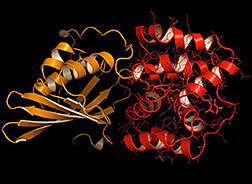- Number 445 |
- August 10, 2015
Orange is the new red

Translocation of the carotenoid pigment
within a critical light-sensitive protein
called the Orange Carotenoid Protein
triggers a shifting of the protein from the
light-absorbing orange state to the
energy-quenching red state, providing
cyanobacteria with protection from too
much sunlight.
Overexposure to sunlight, which is damaging to the natural photosynthetic systems of green plants and cyanobacteria, is also expected to be damaging to artificial photosynthetic systems. In a study led by Cheryl Kerfeld, a structural biologist with DOE's Berkeley Lab, researchers found that in cyanobacteria protection from too much solar energy is triggered by an unprecedented, large-scale movement (relatively speaking) from one location to another of a critical light-sensitive protein called the Orange Carotenoid Protein (OCP). As a result of this translocation, the OCP interacts with a different set of amino acid neighbors causing it to shift from an “orange” sunlight-absorbing state to a “red” solar energy-quenching state. This turns out to be an unanticipated molecular priming event in photoprotection.
[Lynn Yarris, 510.486.5375,
lcyarris@lbl.gov]
